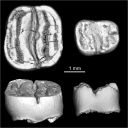















| Plane | Position | Flip |
| Show planes | Show edges |
0.0
M3#713
Right lower molar (m1 or m2). The specimen was scanned with a resolution of 4.5 µm using a μ-CT-scanning station EasyTom 150 / Rx Solutions (Montpellier RIO Imaging, ISE-M, Montpellier, France). AVIZO 7.1 (Visualization Sciences Group) software was used for visualization, segmentation, and 3D rendering. This isolated tooth was prepared within a “labelfield” module of AVIZO, using the segmentation threshold selection tool.
Data citation:
Laurent Marivaux , Jorge Velez-Juarbe
and Pierre-Olivier Antoine
, 2021. M3#713. doi: 10.18563/m3.sf.713
Model solid/transparent

|
3D models related to the publication: An unpredicted ancient colonization of the West Indies by North American rodents: dental evidence of a geomorph from the early Oligocene of Puerto RicoLaurent Marivaux, Jorge Velez-Juarbe and Pierre-Olivier AntoinePublished online: 16/07/2021Keywords: Caribbean islands; Geomorpha; Paleobiogeography; Paleogene; Rodentia https://doi.org/10.18563/journal.m3.128 Abstract This contribution provides the raw files for the μCT-scan data and renderings of the three-dimensional digital models of two fossil teeth of a geomyin geomorph rodent (Caribeomys merzeraudi), discovered from lower Oligocene deposits of Puerto Rico, San Sebastian Formation (locality LACM Loc. 8060). These fossils were described, figured and discussed in the following publication: Marivaux et al. (2021), An unpredicted ancient colonization of the West Indies by North American rodents: dental evidence of a geomorph from the early Oligocene of Puerto Rico. Papers in Palaeontology. https://doi.org/10.1002/spp2.1388 See original publication M3 article infos Published in Volume 07, issue 03 (2021) |
|